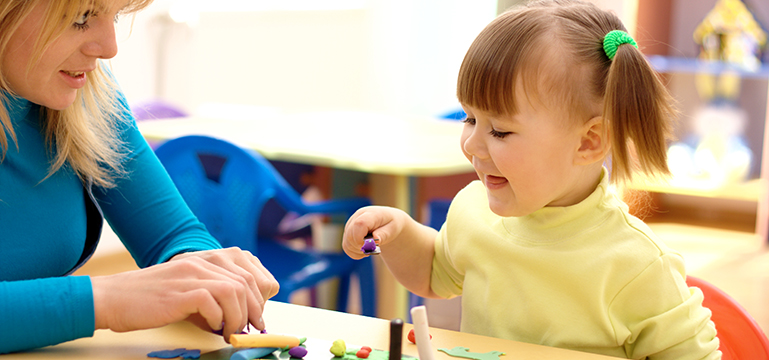Embracing children’s interests to inspire mathematical development

Information about the setting
Cylch Meithrin Cefneithin Gorslas is a Welsh-medium setting that meets in a dedicated cabin in Crosshands Leisure Park, in Carmarthenshire local authority. The setting is open five mornings a week and is registered to admit 20 children between two and four years old. Eight children are funded to receive early years education.
Most children are from white British backgrounds and a few come from Welsh-speaking homes. There are currently no children with additional learning needs.
The setting employs three full-time practitioners, including the leader, and a part-time practitioner. The leader was appointed to the post in October 2011.
Context and background to sector-leading practice
The setting’s main aim is to ensure that all children are challenged successfully to develop their skills across the curriculum in order to make the best possible progress in all aspects of their education. In order to do so, practitioners discuss the children’s favourite interests at the beginning of each term before planning activities and tasks in the learning areas, in line with children’s aspirations. Two themes that are discussed regularly are ‘Dinosaurs’ and ‘Pirates’. The setting’s strength is the way in which it creates colourful, stimulating and attractive continuous learning areas for children that are based on these themes, to captivate them to explore and create in order to develop their literacy and numeracy skills.
Description of nature of strategy or activity
The setting prioritises promoting children’s mathematical development. Practitioners use the foundation phase profile assessments to establish a starting point and consider the assessment outcomes carefully while planning and changing learning areas. This enables them to challenge all individuals successfully by including activities that develop each individual’s numeracy skills effectively. They do this carefully through a range of activities that enable children to work independently and build on previous knowledge and understanding. A notable aspect of the practitioners’ work is the way in which they plan activities that develop children’s understanding of the properties of two-dimensional shapes, as well as their skills in creating and reading maps. For example, they use the dinosaur theme to focus on shape. When presenting a new dinosaur each week, children print a new shape on the dinosaurs’ backs, such as circles on the diplodocus, squares on the tyrannosaurus, semi-circles on the triceratops and triangles on the brontosaurus. As practitioners add new shapes, such as a heart and a quarter-circle, children gradually become familiar with discussing the individual properties of these shapes.
To develop children’s understanding of two-dimensional shapes further, practitioners include the shapes in the pirate role-play cupboard. Here, children create collages of a parrot, a pirate ship and Barti Ddu’s hat by using shapes such as a semi-circle and quarter-circle. They also use different shapes in the sand to create a treasure chest full of gems in two-dimensional shapes. Children are given very good opportunities to cut two-dimensional shapes out of shiny paper and stick then as ‘treasures’ in the treasure chest.
In order to develop children’s early mapping skills, practitioners discuss a story about pirates finding treasure. This places a focus on the following items – a ship, treasure, a hat, an island and a map. Practitioners painted a map on the floor of the setting to introduce the idea of travelling from one side to the other. Although it was a very simple map, it included a number of specific locations, such as the island itself, the ship and the treasure. The north pole and south pole were added. In order to reach the island, children have to walk from the ship along a ‘wooden plank’, before jumping across the shark at the end. This was a physical task to begin with, namely jumping and balancing. The task developed to become much more as the children gave each other directions to follow specific paths across the island. The children created their own treasure maps before programming a Beebot to travel from north to south to find the treasure.
What impact has this work had on provision and learners’ standards?
As a result of this careful planning, many children have excellent numeracy skills, and most acquire their skills very confidently and independently across the areas of learning. A majority have a very good understanding of common two-dimensional shapes, in addition to the properties of complex shapes, such as a star and a pentagon, when creating pictures that relate to the theme. A minority name and recognise semi-circles and quarter-circles correctly when using them to create collages of a pirate ship and a colourful parrot. A few develop particularly good skills in creating and reading maps, and know that a map of a treasure island needs to be held with north facing upwards. They give clear oral instructions about how to go from one side of the island to the other, and draw a path in order to find the treasure. Many handle a wide range of mathematical equipment skilfully to count and classify objects correctly, using appropriate mathematical language.
How have you shared your good practice?
A number of practitioners have already visited the setting in order to improve provision for skills across the curriculum.